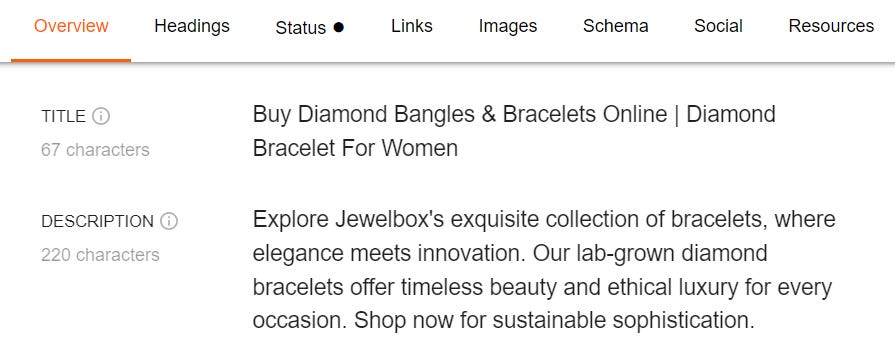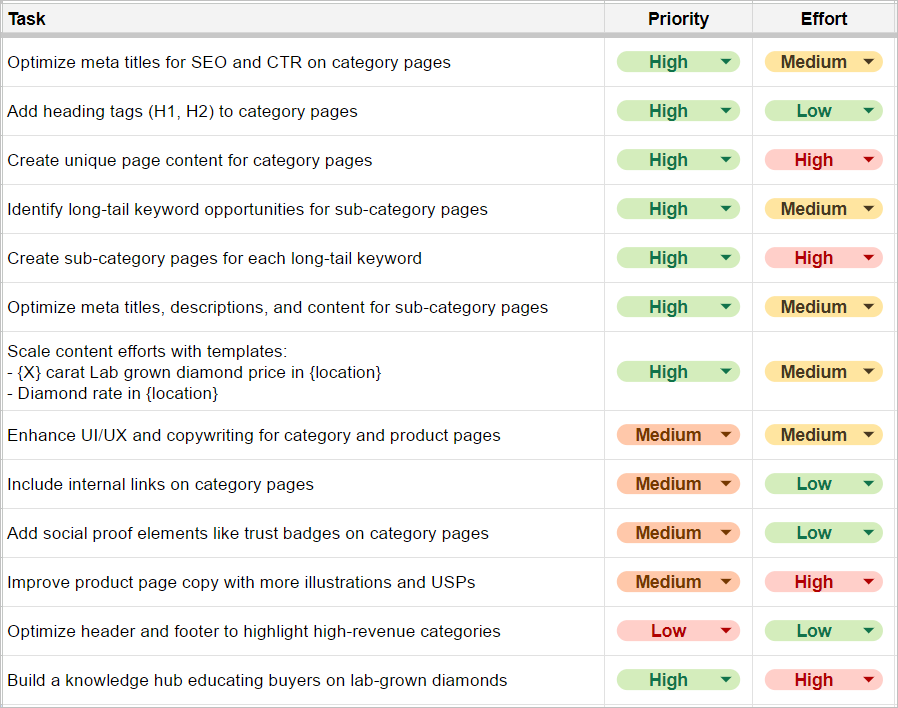#116 How I'd grow SEO for JewelBox.co.in (Roadmap)
Creating SEO roadmap for an eCommerce store (#116 of SEO Growth Notes)
In this newsletter episode, I will create an SEO strategy and action plan for an eCommerce website called— JewelBox, a lab-grown diamond jewellery brand.
Video version of this newsletter (watch on YouTube):
Here’s what’s covered in this guide:
Background of the website and business model
The current state of the SEO
Finding easy SEO wins
Planning content strategy
Content scale opportunities
TL;DR (SEO plan)
Disclaimer: I am not associated with the JewelBox company. This SEO strategy roadmap is created just for educational purposes.
Find all our previous SEO case studies →
Background of the website and business model
JewelBox has been featured in SharkTank India 2024 which helped them gain a lot of social attention. They manufacture lab-grown diamonds and mostly sell their products from online and offline stores.
The current state of the SEO
The website gets almost ~47K organic visitors every month, which is a good number for a high-price ecommerce store.
Number of indexed pages: ~1,830
Site authority: 12
Site traffic: 46.9K
The key advantage they have is high brand value. Because of the SharkTank popularity, people relate their brand directly with lab-grown diamonds— as previously we didn’t have any brand name that we can think of for lab-grown diamonds.
This is one of the reasons (along with good brand story links) that this website is ranking for some high search volume and broad keywords.
Finding easy SEO wins
Let’s start with finding easy SEO win opportunities for this online store.
For ecommerce sites, the key pillars of SEO growth are:
Category pages
Product pages
The reason is in most of the product-related queries, category pages rank in the top results instead of blog articles and product pages.
Easy-SEO wins #1. Lack of category page optimization
The category pages lack the following elements to get higher rankings:
Meta titles are not optimized for SEO and CTR purposes
Here’s an example:
This is still better than many under-optimized online stores.
However, the titles can be improved by making them more clickworthy.
Here’s a template I use to optimize meta titles:
Heading tags (No H1 and H2 tags)
Unique page content that improves page relevance and includes internal links
Here’s a simple content template Jewelbox can use for its primary category pages:
- Category page introduction
- Types of {product category} diamonds
- Describe each type or subcategory using H3s
- FAQs regarding users’ queries regarding lab-grown diamonds
- Pricing table linking to all sub-category pages
Here’s an example of using a pricing table on category/sub-category page content:
Easy-SEO win #2. Targeting long-tail keywords with sub-category pages
Currently, the category and sub-category pages are quite broad in terms of keyword targeting.
Here are the secondary category pages under bracelets:
They can easily target long-tail keywords (low search volume, high buying intent) such as:
Tennis diamond bracelet
Diamond bracelets for men/women
Diamond bracelets with pearl
And so on…
This way they can find many more long-tail page ideas for all of their product categories.
Easy-SEO win #3. Fixing UI/UX and navigation structure
Based on the quick observation, I found some areas where JewelBox can easily make changes. This includes:
Lack of social proof in category pages (include more trust badges)
Poor blog UI/UX (No CTA inclusions, font size/colour, sidebar CTA missing)
Product page copywriting (include more illustrations, copywriting elements, product features, and USPs)
Header and footer optimization (High focus on highlighting high revenue-generating products/categories)
Planning content strategy
I don’t prefer any step-by-step process for content strategy building, as every site is different and their business verticals.
In this case, I’d approach the keyword research in these ways:
Audience research
Keyword research and grouping
Phase 1: Audience research
A simple way to know what pain points, doubts, questions, and concerns your audience has is by looking at the questions posted online. Here’s how to execute this process:
Go to Quora.com and search for your topic (in this case, lab-grown diamonds or artificial diamonds)
Select questions published recently
Extract questions and URLs from Quora (use Chrome extensions like Scraper)
Export these questions and URLs into a G sheet
Map each question to a keyword theme — each question is an opportunity to find a real audience challenge or knowledge gap within the niche.
You can repeat this process for Reddit and any other forums as well.
💡 After digging into this niche and from my understanding I found that people are concerned about the quality of lab-grown diamonds— this is why many questions show fear of buying or deep concerns about the product.
For example: Are lab-grown diamonds to be as valuable as natural diamonds?
Other questions:
Watch my video tutorial to know how to perform Quora audience research for SEO:
No matter what SEO tool you use, you will never discover the actual pain points if you see a keyword as only a traffic opportunity.
Therefore always check what questions your audience asks related to your product niche.
Action items: Build a knowledge hub about educating buyers on why artificial diamonds are as valuable as natural diamonds.
Phase 2: Keyword research and grouping
I am not going deep into how to create a keyword list as there are many useful resources available.
You can simply either of the ways to create your keyword list:
Competitors keyword analysis
Start with seed keywords
Check keyword gap
Once you have the keyword list, ensure to add two new columns such as:
Business relevance (high/med/low)
Ranking difficulty (high/med/low)
You need to manually enter these details into all of your keyword lists (or you may ask AI tools to group keywords by business relevance).
Then use keyword clustering tools like KeywordInsights to group them by SERP results (basically knowing whether you need to create multiple pages for a set of keywords or you can target multiple keywords with one page).
Scale content efforts with templates
Whenever we start our SEO work for clients, we always try to find keyword opportunities where we can scale using the same content templates.
In this case, we found a couple of keyword opportunities such as:
{X} carat Lab-grown diamond price in {location}
Diamond rate in {location}
Now, they can create dedicated pages for these search queries for hundreds of cities and regions in India. And all they need to do is follow this process:
Create a content template to set what headings to cover, page layouts, and instructions for writer
Writers will keep creating pages for all location
Publish them
You don’t need to create a content brief manually for each page— it’s an easier way to scale your content and SEO results.
💡 Why this is important for Jewelbox:
These keywords are related to diamonds (not related to lab-grown diamonds). This is why by ranking for these pages, they can educate information about their products and make users product aware.
TL;DR of SEO plan
That’s all.
Need help in scaling your SEO growth and results? Let’s connect!
Connect on LinkedIn
Email at info@accrueserp.com















